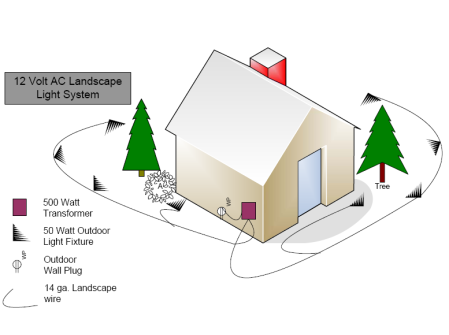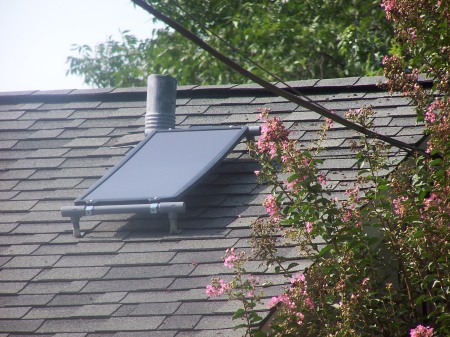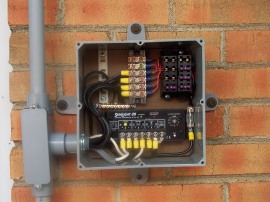
Heavy misting of the sprinkler heads can result in as much as a 25% loss in water.
New sprinkler heads and nozzles coming on the market are claiming sizable water savings, but how much water can you really save (if any)? Stream sprayers are normally found only in orbital or rotary heads and are typically found in larger landscaped areas and can be spaced 20′ to 30′ apart. With an open landscape, these heads can water more ground with less water. Up until now, there have been few options for smaller residential properties other than traditional pop-up heads using spray type nozzles. Spray nozzles are designed for spacing limitation from 8′ to 15′ and as with any type water sprayer, there is a correlation between distance and trajectory or arc necessary to obtain the distance. The greater the distance, the greater the height of the arc to obtain the distance. Greater distance = greater misting.
But trajectory alone is not the only culprit to misting. High winds, high pressure, evaporation and excessive overspray all contribute to the water loss factor associated with misting. This misting can account for a loss of 10-25%. It’s this misting factor (more characteristic of spray nozzles over stream nozzles) that contributes to a lower efficiency found with the spray nozzle. And its the low misting factor found with the stream sprayer that makes for an attractive alternative.
In an attempt to make automatic sprinkler systems more efficient, some manufacturers have created a stream type nozzle designed as a direct replacements for the standard spray nozzle (aka pop-up sprayer). If you have read my earlier posts on lawn sprinklers you know that pop-up type spray heads can lose 10% or more of their water spray to the wind and evaporation. Before we look at the differences between spray nozzles and stream nozzles, lets consider the ways to reduce sprinkler misting. Some of these items can be readily addressed, some are design considerations.
Standard Spray Nozzles: Standard spray nozzles atomize the water to equally spray or spread the water out in an even flow throughout their spray pattern. They are great choice for small residential properties as they provide good water distribution in a reasonable amount of time. Additionally they have many different nozzles to fit the various application requirements.

- To much pressure: Optimally pop-up sprayers work best at 30 psi. High pressure can cause excessive misting. TIP: To test the zone water pressure, you have to remove a head, replace it with a riser and thread on a water pressure gauge, then run the zone and check the pressure while the zone is spraying water.
- Don’t water during high winds: This can be managed manually or you can add a wind anemometer to your sprinkler controller that will shut down the system at certain wind speeds. Even though we typically water in the night-time hours (to avoid excessive evaporation), windy conditions are as common during the night-time as during the day.
- Keep water spray output close to the ground: This can be achieved by designing a system where the heads are closer (such as 10′ apart compared to 15′ apart) Spray nozzles with shorter patterns use lower trajectories, will atomize the water less and have less distance to fall to the ground. This item has to be addressed during the initial design as shortening patterns in an existing system could be considered a “do over”. I designed and installed my current system prior to stream sprayers, I took this approach by using 10′ radii heads. The water stays very close to the ground when the system is running. Granted, it caused me to use a lot more heads and zones. If I were to tackle it today, the stream sprayers would not only impact my water usage, but cut back on material and zones installed.
- Deliver the water in streams not in a spray or mist: The more you atomize the water, the lighter it becomes, allowing the wind to cause the water to drift away and evaporate before it has time to absorb into the ground or plant material.
- Deliver water directly to the roots through drip irrigation. Flower beds can be easily converted (assuming your sprinkler system has specific zones for flower beds). For grass and turf this is a bit more involved but plausible. In my current system I created specific zones for the parkway and driveway. Using direct bury drip lines, I am able to keep the turf green with virtually no run off. This is another condition that would need to be addressed in the original design.
- Refer to the Alliance of Water Efficiency, for additional water saving tips.
Water Use and Abuse
There is a fine line between efficient water delivery and adequate water coverage. Many irrigators will “over cover” an installation to ensure all the grounds receive adequate water. The Irrigator wants to over-saturate the turf to avoid brown spots or low coverage areas, as making a re-trip to install additional heads can be costly. Creating a system that uses excessive water will cause them less problems in the long run. But in doing so, there may be a high degree of waste associated with the design. Don’t get me wrong, the lawn sprinkler business is very competitive and most people won’t spend the money to get a system with high-efficiency. Since water is still cheap and fairly plentiful this methodology will be with us for a while. However, the purpose of this article is to attempt to make your existing system more efficient and if you have a decent design, you can make some reasonable changes that will not terribly affect the performance of the system.
 Stream Sprayers: Stream spray nozzles provides multiple streams from the nozzle in the defined pattern (90, 180, 360 degree pattern). To provide adequate coverage, the streams spray in a rotation throughout the pattern. The beauty of the stream type nozzle over the spray nozzle is it will project water similar distances without high levels of misting. However, based on their delivery you may actually have to run the systems longer to get similar watering results, but since they are more efficient, it will not negatively impact the system performance. With the move toward greater efficiency, the stream principle has been introduced to traditional pop-up sprayer. Some manufacturers provide them as replacement nozzles, where others require you to change out the complete head. TIP: Look at one of your spray heads to determine the brand, go online to see if the manufacturer makes a replacement nozzle, don’t be surprised if your local orange box store does not carry them. I have used Sprinkler Warehouse for many of my sprinkler parts and speciality items.
Stream Sprayers: Stream spray nozzles provides multiple streams from the nozzle in the defined pattern (90, 180, 360 degree pattern). To provide adequate coverage, the streams spray in a rotation throughout the pattern. The beauty of the stream type nozzle over the spray nozzle is it will project water similar distances without high levels of misting. However, based on their delivery you may actually have to run the systems longer to get similar watering results, but since they are more efficient, it will not negatively impact the system performance. With the move toward greater efficiency, the stream principle has been introduced to traditional pop-up sprayer. Some manufacturers provide them as replacement nozzles, where others require you to change out the complete head. TIP: Look at one of your spray heads to determine the brand, go online to see if the manufacturer makes a replacement nozzle, don’t be surprised if your local orange box store does not carry them. I have used Sprinkler Warehouse for many of my sprinkler parts and speciality items.
The Test Case: I created a model zone with 4 heads, 2-180 degree heads and 2-360 degree heads. I used the Toro 570 model body as it can be equipped with either the spray nozzle or retrofitted with the stream nozzle. Optimally, the comparison is based on a 30 psi rating at the head.
In converting the system from spray to stream we need to match the pattern as close as possible. Since spray heads are a mature product, many patterns and styles are available, but with the stream nozzles, the available styles are still limited. With the Toro brand, the new stream nozzles are not a direct comparison in spray distances and the stream nozzles may have to be tuned to reduce the pattern to avoid excessive over-spray onto the sidewalk. But they were pretty close.

Spray Nozzles De-rated by 10%

Spray Nozzles De-rated by 25%%
From a cost comparison, it is beneficial to be able to re-use your existing spray heads if at all possible, as having to buy new heads as well as the nozzles will add up quickly. When you look at the water saved vs. the cost of the change, it did not prove out (for me) since water is still very cheap. However many municipalities tack on additional charges based on water usage, so it could make a difference for you. If you are interested in seeing how much difference it makes, take the water saved (listed in the table and calculate it against your dollar per gallon charges found on your water bill.
Based on the results of the chart, here is my observations using the 10% de-ration chart.
- It requires 86.72 minutes using the stream spray nozzles to provide the same precipitation value as the spray nozzle provides in 60 minutes.
- Even though it requires 26.72 minutes more, the stream sprayers use 393 less gallons
- Factoring in a 10% misting factor, the stream sprayers use 5.77% less water or 471.63 gallons of water per month.
At a 25% deration the numbers are a bit more dramatic as you could save over 1700 gallons of water per month.
Conclusion:
- Consider using the stream sprayers in a new design as you can use less heads, less zones, less pipe, less fittings as well as less water.
- Convert existing sprinkler zones to stream sprays where high wind is normal or misting is excessive.
Recommendation: If you choose to replace your existing nozzles/heads, change one zone at a time. Let it run through part of the season, compare the results by looking at your turf . For proper watering don’t mix spray nozzles with the stream nozzles in the same zone. To obtain an adequate amount of water similar to the spray nozzles zones, the watering time may have to be increased on the stream nozzle section.
To see the entire series of lawn sprinkler articles go to Lawn Sprinkler tab on the HomeownerBOB web page.
Good Luck
 Finding a lost sprinkler head can be a challenge, simple in concept but difficult if you don’t have a plan. Sprinkler heads can fail to rise to the occasion when under pressure. The longer they fail to operate the harder they may be to find.
Finding a lost sprinkler head can be a challenge, simple in concept but difficult if you don’t have a plan. Sprinkler heads can fail to rise to the occasion when under pressure. The longer they fail to operate the harder they may be to find.  Okay, that was the easy stuff, now it gets hard. Go to the Orange Box store and purchase some sprinkler flags. Place a flag at each known head. Measure the distances between the heads as shown in the drawing. You should find an area that does not measure (in relative terms) like the other ones. Start poking around with a shovel (carefully) in an attempt to expose the head
Okay, that was the easy stuff, now it gets hard. Go to the Orange Box store and purchase some sprinkler flags. Place a flag at each known head. Measure the distances between the heads as shown in the drawing. You should find an area that does not measure (in relative terms) like the other ones. Start poking around with a shovel (carefully) in an attempt to expose the head 


 Posted by homeownerbob
Posted by homeownerbob 















